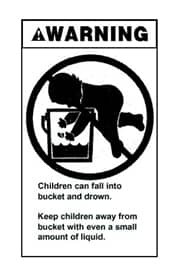Consumer Product Safety Commission Infants & Toddlers Can Drown in 5-Gallon Buckets
A Hidden Hazard In The Home
 Large buckets and young children can be a deadly combination. The U.S. Consumer Product Safety Commission (CPSC) has received reports of over 275 young children who have drowned in buckets since 1984. Over 30 other children have been hospitalized. Almost all of the containers were 5-gallon buckets containing liquids. Most were used for mopping floors or other household chores. Many were less than half full.
Large buckets and young children can be a deadly combination. The U.S. Consumer Product Safety Commission (CPSC) has received reports of over 275 young children who have drowned in buckets since 1984. Over 30 other children have been hospitalized. Almost all of the containers were 5-gallon buckets containing liquids. Most were used for mopping floors or other household chores. Many were less than half full.
Of all buckets, the 5-gallon size presents the greatest hazard to young children because of its tall, straight sides and weight, even with just a small amount of liquid. At 14-inches high, a 5-gallon bucket is about half the height of a young child. That, combined with the stability, makes it nearly impossible for top-heavy infants and toddlers to free themselves when they fall into the bucket head first. A child can drown in a small amount of water.
Children are naturally curious and easily attracted to water. At the crawling and pulling up stages while learning to walk, they can quickly get into trouble. CPSC believes that bucket drownings happen when children are left momentarily unattended, crawl to a bucket, pull themselves up, and lean forward to reach for an object or play in the water.
Parents and caregivers who are using 5-gallon buckets for household chores are warned not to leave a bucket containing even a small amount of liquid unattended where a young child may gain access to it. A child can drown in the time it takes to answer a telephone.
Prevent Child In-Home Drowning Deaths
The U.S. Consumer Product Safety Commission (CPSC) warns consumers about hidden drowning hazards for small children in and around the home. Recent data show that a third as many children under age 5 (an average of about 115 annually) drown from other hazards around the home as drown in pools. Many of these deaths are associated with common household products. For example:
- About two-thirds of the drowning deaths in the home, not including pools, occur in bathtubs. Some of these bathtub drowning deaths happened when children were in bath seats or rings.
- 5-gallon buckets, often used for household chores, pose a serious threat to toddlers. Their tall, straight sides combined with their stability make it nearly impossible for top-heavy infants to free themselves when they topple in headfirst.
- Toilets are often overlooked as a drowning hazard in the home. The typical scenario involves a child under 3-years-old falling headfirst into the toilet.
- Spas and Hot Tubs pose another drowning hazard. A solar cover can allow babies to slip into the water while the cover appears to stay in place, hiding the child.
- Childhood drowning deaths also occur in other containers that may contain liquids, including coolers, sinks, fish tanks and landscape ponds. CPSC offers these safety tips to help prevent childhood drowning deaths in and around the home. NEVER leave a baby alone in a bathtub even for a second. Always keep baby in arm’s reach.
- NEVER leave young children alone or with young siblings in a bathtub even if you are using a bath seat or ring. Children can drown quickly and silently.
- Keep the toilet lid down, and keep young children out of the bathroom when unsupervised. Consider placing a latch on the bathroom door out of reach of young children.
- Be sure all containers that contain liquids are emptied immediately after use. Do not leave empty containers in yards or around the house where they may accumulate water and attract young children.
- Always secure the safety cover on your spa or hot tub.
- Learn CPR (cardiopulmonary resuscitation) – it can be a lifesaver.


